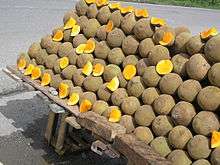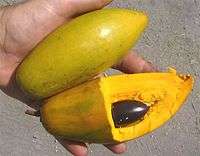Sapote
Sapote (from Nahuatl tzapotl)[1] is a term for a soft, edible fruit. The word is incorporated into the common names of several unrelated fruit-bearing plants native to Mexico, Central America and northern parts of South America. It is also known in Caribbean English as soapapple.
 White sapote
White sapote
- Lòng mứt, a kind of Vietnamese sapote



 Black sapote | |
| Type | Fruit |
|---|---|
| Region or state | Mexico, Central America and northern parts of South America |
Sapotaceae
Some but not all sapotes come from the family Sapotaceae:
- Sapodilla, also called naseberry (Manilkara zapota) is native to Mexico, Guatemala, Nicaragua, Belize, and possibly El Salvador. The Sapotaceae were named after a synonym of this species.
- Yellow sapote (Pouteria campechiana) is native to Mexico and Central America.
- Mamey sapote (Pouteria sapota) is from southern Mexico to northern South America.
- Green sapote (Pouteria viridis) is native to lowland southern Mexico.
Ebenaceae
Sapotes from the family Ebenaceae include:
- Black sapote (Diospyros nigra), from eastern Mexico south to Colombia, is probably the original Aztec tzapotl.
- Chapote (Diospyros texana) is native to the lower Rio Grande valley region in Texas and Mexico
Other sapote
- White sapote (Casimiroa edulis: Rutaceae) is native to northern and central Mexico, Costa Rica, El Salvador and Guatemala.[2]
- South American sapote (Quararibea cordata: Malvaceae) is native to the Amazon rainforests of Brazil, Colombia, Ecuador, and Peru.
gollark: ... what happened to edgex?
gollark: ```.... ....```
gollark: That is not a problem. The lack of required moderation actions is a GOOD thing.
gollark: I know I haven't exactly done much as a staff, but there doesn't seem to be much staffing which needs doing and/or that I can do.
gollark: How weird.
References
- Watson, George (April 1938). "Nahuatl Words in American English". American Speech. 13 (2): 113–114. doi:10.2307/451954. JSTOR 451954.
- "Casimiroa edulis". Germplasm Resources Information Network (GRIN). Agricultural Research Service (ARS), United States Department of Agriculture (USDA). Retrieved 2009-03-26.
This article is issued from Wikipedia. The text is licensed under Creative Commons - Attribution - Sharealike. Additional terms may apply for the media files.